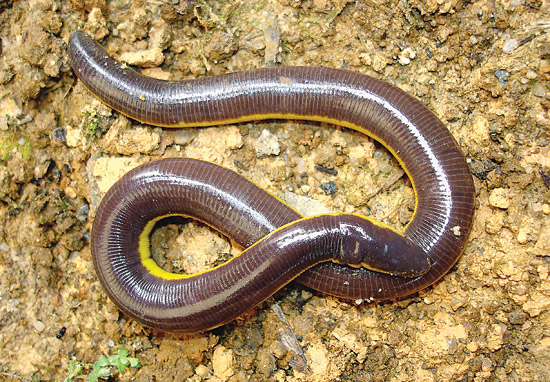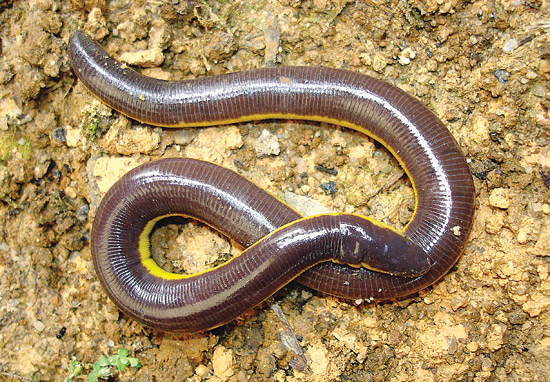(No.12, Vol.2, Dec 2012 Vietnam Heritage Magazine)
In the world of amphibians, the process of metamorphosis from an egg to a larva and to an adult amphibian goes through a very complicated and unique cycle. After being hatched from an egg, a larva has to live in water until it develops organs to adapt to terrestrial lifestyle and loses its tail, which is a very useful body part for aquatic lifestyle. The Yellow-Striped Ceacillian (Ichthyophis bannanicus) is a very special amphibian.
The Yellow-Striped Ceacillian belongs to the Ichthyophiidae family, Gymnophiona order. This species is worm-like, but is bigger than worms. It is different because its head has eyes like two black spots. Its head is also a little flat and its mouth is relatively pointed with a clear jaw. A Yellow-Striped Ceacillian’s back is bluish-grey and lighter at its belly. There are two opalescent or yellow bands running from two sides of its jaw to its tail. Its body length can reach to 100mm.
The Yellow-Striped Ceacillian often lives at 900-1,000 (metres) in altitude. It has a subterranean lifestyle, living under soil near lakes or creeping under big rocks near streams. It consumes worms and different insects.
Between May and June, when rain falls in every forest in Vietnam, increasing humidity and making streams, the best conditions for Yellow-Striped Caecillians to mate and reproduce are created, especially in the humus area at the understory of forests. They lay eggs near water with high humidity. A litter will consist of about 20-30 eggs. They are linked together by mucus and the female caecillian is in charged of holding these eggs, to protect them from drying out as well as control the temperature. The female Yellow-Striped Caecillian is considered the best mother in the world of amphibians. Most of amphibians will leave eggs after laying them.

Ichthyophis nguyenorum

Ichthyophis bannanicus
In recent years, Yellow-Striped Caecillians have been discovered at some new places in Vietnam: Xuan Son, Thanh Son Commune (Phu Tho Province), Ba Vi District (Hanoi), and a small population at Tan Lap Commune (Hoa Binh Province). Since this species only lives in moist soil, it is easily endangered by deforestation, soil erosion, use of pesticides and chemical fertilizers and prolonged flood, which causes them to suffocate in soil. Because it is a rare species, Yellow-Striped Caecillians has been added to Vietnam Red List.
Japanese and Russian scientists have discovered and published a new species of caecillian based on three specimens collected from field research at Kon Tum Highland, Central Vietnam in 2006. Description of this ceacillian was published on Current Herpetology magazine of Japan, issue number 31, 2012. The ceacillian is called the Nguyen Caecillian (Ichthyophis nguyenorum Nishikawa, Matsui & Orlov 2012), named after two Vietnam’s herpetologists, Nguyen Quang Truong (Institute of Ecology and Biological Resources, IEBR) and Nguyen Thien Tao (Vietnam National Museum of Nature), who have made many contributions in discovering new species in Vietnam. This is also the second caecillian recorded in Vietnam, after the Ichthyophis Bannanicus, which was recorded in Northern Vietnam. According to the description of Nishikawa and other authors (2012), the new caecillian is about 265-307mm long, cylinder-shaped and a little flat at its belly. Its back is purplish-black, lighter at its belly with lilac colour and yellow at its two bands running continuously at its two sides from its mouth to its tail.
,,
,,

